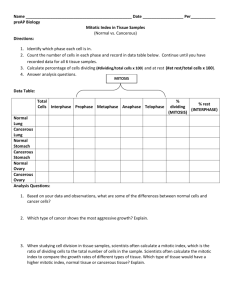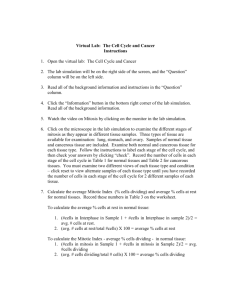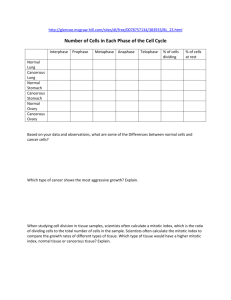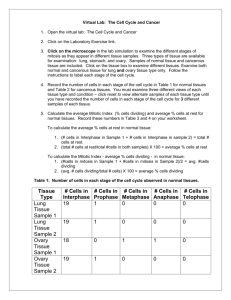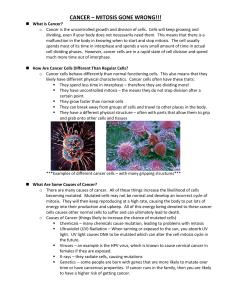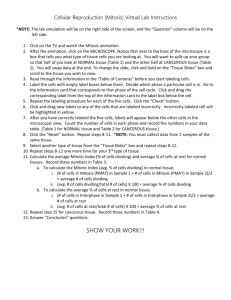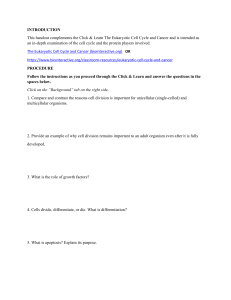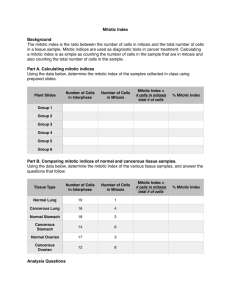Using Statistical Observations of Mitosis to Determine Likelihood of
advertisement
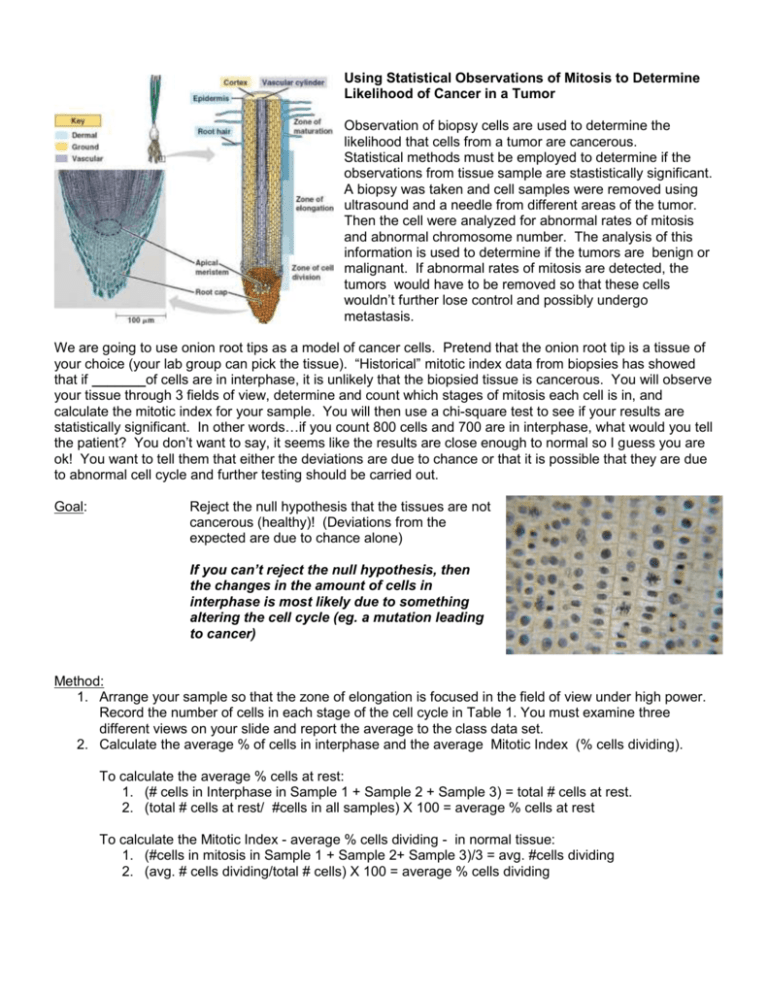
Using Statistical Observations of Mitosis to Determine Likelihood of Cancer in a Tumor Observation of biopsy cells are used to determine the likelihood that cells from a tumor are cancerous. Statistical methods must be employed to determine if the observations from tissue sample are stastistically significant. A biopsy was taken and cell samples were removed using ultrasound and a needle from different areas of the tumor. Then the cell were analyzed for abnormal rates of mitosis and abnormal chromosome number. The analysis of this information is used to determine if the tumors are benign or malignant. If abnormal rates of mitosis are detected, the tumors would have to be removed so that these cells wouldn’t further lose control and possibly undergo metastasis. We are going to use onion root tips as a model of cancer cells. Pretend that the onion root tip is a tissue of your choice (your lab group can pick the tissue). “Historical” mitotic index data from biopsies has showed that if _______of cells are in interphase, it is unlikely that the biopsied tissue is cancerous. You will observe your tissue through 3 fields of view, determine and count which stages of mitosis each cell is in, and calculate the mitotic index for your sample. You will then use a chi-square test to see if your results are statistically significant. In other words…if you count 800 cells and 700 are in interphase, what would you tell the patient? You don’t want to say, it seems like the results are close enough to normal so I guess you are ok! You want to tell them that either the deviations are due to chance or that it is possible that they are due to abnormal cell cycle and further testing should be carried out. Goal: Reject the null hypothesis that the tissues are not cancerous (healthy)! (Deviations from the expected are due to chance alone) If you can’t reject the null hypothesis, then the changes in the amount of cells in interphase is most likely due to something altering the cell cycle (eg. a mutation leading to cancer) Method: 1. Arrange your sample so that the zone of elongation is focused in the field of view under high power. Record the number of cells in each stage of the cell cycle in Table 1. You must examine three different views on your slide and report the average to the class data set. 2. Calculate the average % of cells in interphase and the average Mitotic Index (% cells dividing). To calculate the average % cells at rest: 1. (# cells in Interphase in Sample 1 + Sample 2 + Sample 3) = total # cells at rest. 2. (total # cells at rest/ #cells in all samples) X 100 = average % cells at rest To calculate the Mitotic Index - average % cells dividing - in normal tissue: 1. (#cells in mitosis in Sample 1 + Sample 2+ Sample 3)/3 = avg. #cells dividing 2. (avg. # cells dividing/total # cells) X 100 = average % cells dividing Title: I must know what tissue your analysis focused on. No two lab groups can choose the same tissue type! Abstract: You will do this independently after your group has written the full lab. Use your findings to write an abstract about your patients’ biopsy. Review what goes in an abstract! http://research.berkeley.edu/ucday/abstract.html Introduction: Methods: What tissue is your biopsy from? What do we know about rates of cancer in this tissue? How did you go about systematically observing and analyzing your tissue sample? Fill out the google docs. Each individual in class needs to triple count a sample. This means, we counted 13 samples taken from the tumor. Recognize that you are actually determining which stages are present in your sample. You may need to review in your book how to identify each stage. Data and Analysis: What are the results of your analysis? Mitotic Index and and chi square analysis (remember, we did a chi-square analysis for our first lab-insects!) Variation in cell counts and observation of stages of mitosis (is there consistency between the various samples taken from different parts of the tumor? Is there consistency between the technologists analyzing the samples? Display this using appropriate graphing and statistics) Conclusion: What do your results mean? Why have you interpreted them as you did? What are the next steps to understanding this cancer? In your conclusion, you will: A) Use the data to draw conclusions (explanation of why you drew your conclusions and saw what you saw!) 1) Use the mitotic index data to determine if the patients sample biopsy is deemed “cancerous” 2) Use the class data set to discuss whether the tumor is homogeneous or heterogenous in terms of its cellular makeup. Remember, each biopsy sample was taken from a different part of the tumor. 3) Discuss additional information that could be determined from observing a karyotype of sample cells (research HeLA karyotypes) B) Whether or not your patient has cancer, you will research the particular tissue you chose and talk about at least one common gain of function mutation and one common loss of function mutation. Remember, even benign tumors need to be monitored as the cells could change. So an analysis of this type of tumor is useful either way! You will also discuss what the next steps would be if the tissue was cancerous. How would you go about treating 1) Here you will be using primary sources! C) Discuss experimental error in terms of the data! Works Cited: You may try using scientitific format to cite data or you may use MLA format. Basically the difference is that scientific format uses the date in the paper for internal citations. How old (or recent) the paper is may be important when referencing data. Either way, any time you refer to results from a primary source, you must cite the source.
